Table of contents

counselor
technology & future
Exhaust control systems
Exhaust control systems
Exhaust control systems
Exhaust control systems should increase the torque and thus the power in the lower and middle speed range in two-stroke engines, as well as reduce the emission of unburned fresh gases and thus the fuel consumption.
02/25/2003
Exhaust control systems should increase the torque and thus the power in the lower and middle speed range in two-stroke engines, as well as reduce the emission of unburned fresh gases and thus the fuel consumption.
Especially in high-performance two-stroke engines, the long exhaust control times cause considerable fresh gas losses at low speeds. At the same time, the pressure in the outlet drops sharply, with the result that the compression and thus the efficiency decrease. Therefore one tries to make the timing variable through constructive measures.
Yamaha, for example, developed the YPVS (Yamaha Power Valve System) back in 1977. A roller with a segment-shaped cutout sits on the upper edge of the outlet channel. By turning the roller, the height of the outlet channel changes and thus the control time. The roller is controlled either mechanically via centrifugal actuation or via a servomotor and Bowden cables. This system causes an increase in torque in the lower and middle speed range.
Suzuki also uses the variation of the exhaust valve timing in the new two-stroke engine of the RGV 250. A servomotor moves two cylindrical segments and thus the upper edge of the outlet channel via a linkage.
Rotax developed a system in which the height of the upper edge of the outlet and thus the timing is changed by means of a flat slide. In contrast to the systems mentioned above, it is actuated pneumatically. As the speed increases, the increasing pressure in the exhaust is used to move the slide valve via a membrane.
In addition to the exhaust control times, the gas oscillations in the exhaust have a decisive influence on the pressure conditions in the exhaust port and thus on the performance characteristics of a two-stroke engine. The exhaust length, which is decisive for the pressure conditions at the outlet, can only be adjusted for a narrow speed range. For this reason, systems have been developed which, on the one hand, help to achieve variable control times and, on the other hand, additionally influence the vibration conditions of the exhaust system via switchable chambers. As a result, the compression and ultimately the power output at low speeds was increased again.
Honda first used the ATAC (Auto Control Torque Amplification Chamber) system in 1983. Here a chamber attached to the outlet is switched on and off depending on the speed. By influencing the pressure fluctuations in the exhaust, the usable speed range is wider and the torque curve is improved at low and medium speed.
The KIPS system (Kawasaki Integrated Power Valve System) from Kawasaki works in a similar way. Here, two auxiliary outlets are controlled by rollers depending on the speed. At low speeds, one of the secondary outlets is closed, the second opening into an additional volume. At high speeds, a roller closes the chamber, and at the same time both auxiliary outlets are opened parallel to the main outlet.
Suzuki developed a similar system called SAEC (Suzuki Automatic Exhaust Chamber). A roller with a breakthrough sits above the outlet channel and, when rotated, gives way to an expansion chamber.
With the ATAC system from Honda, an additional volume is switched on in the exhaust system via a flap.
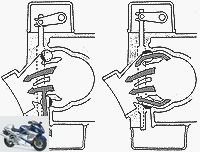
Kawasaki’s Keim KIPS system controls two roller segments, two secondary outlets and an additional volume at the same time.
Left picture: lower speed range
Right picture: Upper speed range.
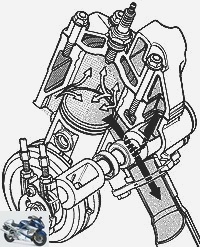
With the Suzuki SAEC system, an additional volume is opened in the lower speed range by turning a roller via a servo motor and Bowden cables.
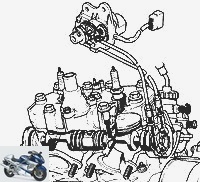
With the YVPS from Yamaha, the upper edge of the outlet is adjusted depending on the speed via roller segments.
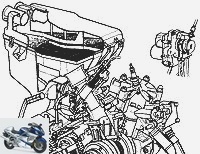
Suzuki varies the height of the exhaust ports on the RGV 250 by means of speed-dependent controlled slides.
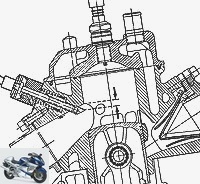
The exhaust control at Rotax works with a flat slide, which is pneumatically controlled via the pressure in the exhaust system.
Related articles
-
Assistance systems: traction control in the test
Jahn 13th pictures Jahn 1/13 The relations shift on the wet test track – in the truest sense of the word. Jahn 2/13 In conclusion, it can be said that…
-
Conversion tips exhaust systems
Hanselmann 8th pictures Debus 1/8 In principle, there are two options when the exhaust is to be replaced. Here is a completely new system from Akrapovic,…
-
Motorcycle exhaust systems from SR-Racing
fact 18th pictures fact 1/18 Sepp Bruckschlogl is the master of the pipes and head of SR-Racing. fact 2/18 Components of the silencer. fact 3/18 Shapes…
-
Exhaust systems for BMW R 1100 S.
accesories Exhaust & silencer Exhaust systems for BMW R 1100 S. Exhaust systems for BMW R 1100 S. Heck-Meck Do accessory exhaust systems make the BMW R…
-
Accessories exhaust systems Germany
Jahn accesories Exhaust & silencer Accessories exhaust systems Germany Accessories exhaust systems Manufacturers and importers in Germany Content of In…
-
Tuning special – exhaust systems
Akrapovic 6th pictures Akrapovic. 1/6 Akrapovic has its own exhaust gas laboratory and its own titanium foundry for the direct implementation of new…
-
Product test: exhaust systems for the Kawasaki Z 1000
jkuenstle.de accesories Exhaust & silencer Product test: exhaust systems for the Kawasaki Z 1000 Product test: exhaust systems for the Kawasaki Z 1000…
-
Cornering ABS and traction control regulate more often than expected
Photo: markus-jahn.com 6th pictures Bosch 1/6 The so-called curve ABS at a slope of 35 degrees on dry asphalt. The driver brakes in an inclined position,…
-
Suzuki patent: Variable valve control 2.0
Suzuki 8th pictures Suzuki 1/8 Suzuki is working on a new variable valve control. Suzuki 2/8 It should serve the inlet and outlet and be hydraulically…
-
Exhaust tuning and performance comparison at Akrapovic
Bilski 27 pictures fact 1/27 Three parameters mainly determine the potential of a bend: the diameter of the pipes, their shape and length. Akrapovic 2/27…